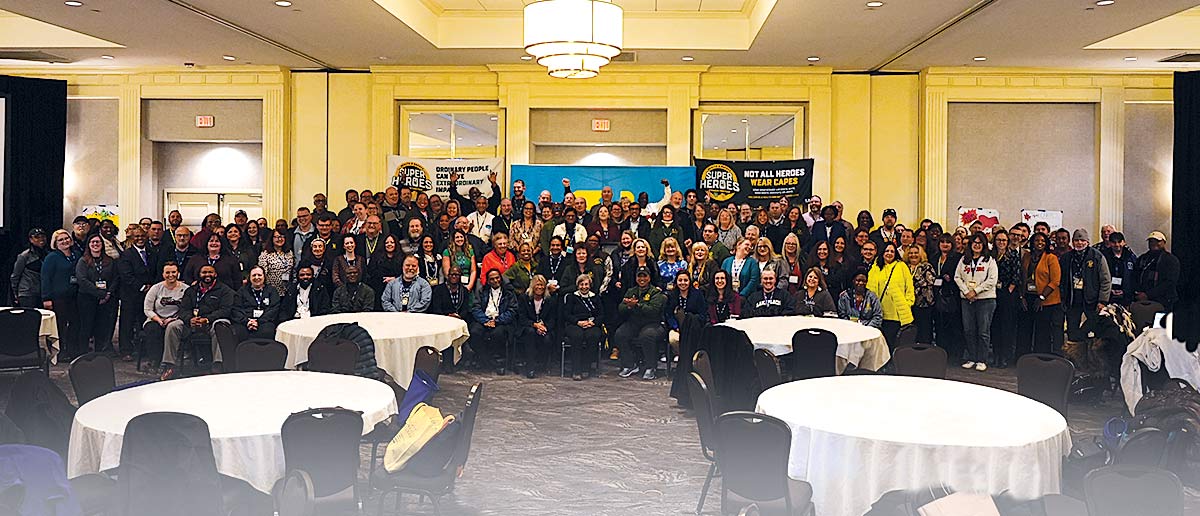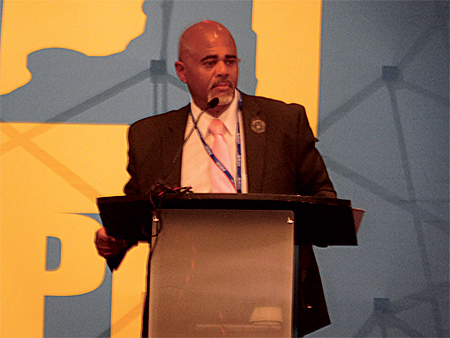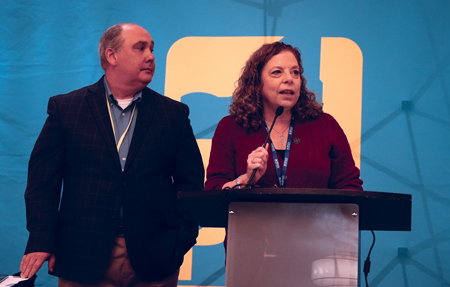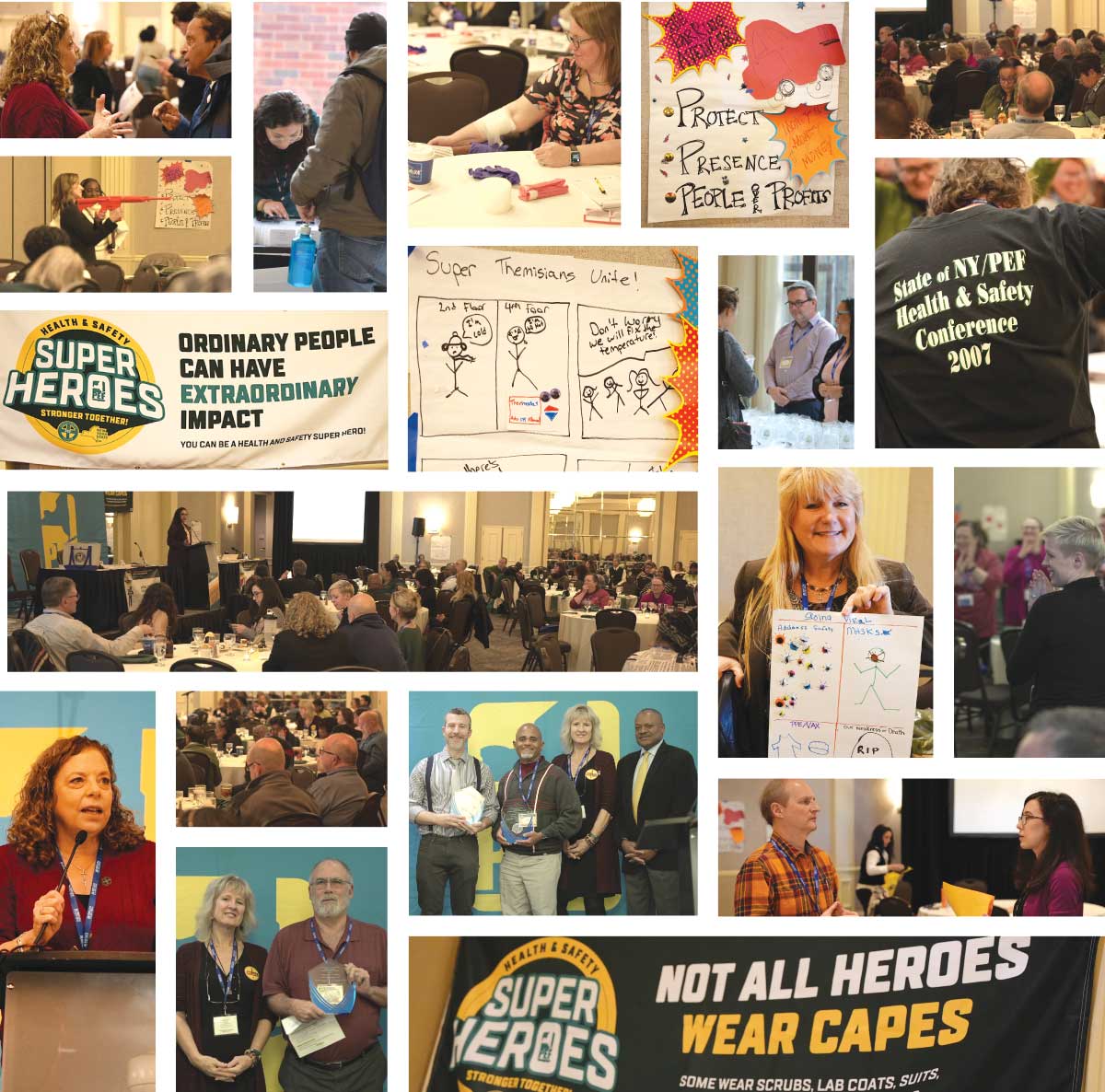
December 21, 2023 — When COVID shut down much of the world, it also had a devastating impact on PEF’s health and safety committees at worksites and agencies across the state.
Hopefully, that’s about to change.
For the first time since 2018, PEF and the State held a joint Health & Safety Conference from December 11 to 13 in Saratoga, bringing together management and labor for three days of workshops, guest speakers, and more.
PEF Article 18 Co-Chairs Conrad Davis and Leisa Abraham welcomed attendees and talked about their plans for the coming year.
“Many worker protection programs were born out of the devastating Triangle Shirtwaist Factory fire in 1911,” said Davis. “Unions were a big part of that fight for safety on the job. But we can’t do it alone – labor and management need to partner to get things done. We are here to support you and to make sure that you have all the resources you need to get your local Health and Safety Committees up and running.”
Abraham urged attendees to take full advantage of what the conference had to offer.
“It can be overwhelming if you don’t know where to start,” she said. “Like many of you, I am also a new health and safety chair, and I am excited about the programs you will be attending here – make the most of it!”
PEF Director of Health and Safety Geraldine Stella gave an overview of the program.
“We are here because COVID decimated our local Health and Safety Committee network,” she said. “This conference program was built around giving you the tools you need to rebuild. Our plenary sessions will help you identify where you have committees, where you need them, and how to recruit for them.
“Our workshops cover everything from basic health and safety committees, workplace violence programs, how to work with different generations, active shooter training and more,” Stella said. “Our theme is ‘Health and Safety Superheroes – Stronger Together!’ You are the next health and safety superheroes.”
President Spence kicks off the night

President Wayne Spence said the world has changed since the last time management and PEF leaders gathered for this conference.
“When we were here last time, we did not know the term COVID,” he said. “How the world has changed. Who would have imagined we’d be here talking about training how to deal with an active shooter? It’s now become a part of life. We have to evolve. We must come together.”
Spence told a story from his own past that illustrates how vital it is to pursue change.
“My partner and I were taking a parolee into detention and she was pregnant. A corrections officer started screaming, ‘Why is a pregnant officer bringing a person into my jail?’ He said, ‘Get her out of here,’” Spence recalled. “When I say she was pregnant, she was very pregnant. Her vest barely covered her stomach.”
They ended up calling in another officer to handle the transfer, but Spence said the corrections officer schooled him in how corrections handles pregnant officers. It made an impact and Spence took it upon himself to begin researching the issue in the parole division. One thing he found striking: water amplifies sound. So, when you fire a gun around a pregnant woman, the fetus is exposed to not just the gunfire, but amplified gun fire.
“What do you think was happening when a pregnant officer was going to the range?” he said. “We must have ear protection when we go to the range. That fetus doesn’t have ear protection.”
He got involved with his local Health and Safety Committee in the Parole Division and took the issue directly to management. “The PEF Health and Safety Department guided me on how to fight for safety on the job.” Taking his research up the chain, to legislators and the media, he finally saw change when he reached the commissioner. “Don’t accept no,” he said. “Let’s not wait for change, let’s do action.”
Spence also recognized the more than 60 state managers in attendance.
“It is just as important for management representatives to work in a safe environment as it is for PEF members,” he said. “I’m told that more managers signed up for this conference than ever before. That’s a tribute to you and the realization that we must work together to ensure that every worker is protected on the job.”
Guest speaker talks Long COVID
President Spence welcomed New York State Insurance Fund (NYSIF) Executive Director and CEO Gaurav Vasisht to the podium to talk about NYSIF and its commitment to researching Long COVID.
Vasisht noted that NYSIF’s study of Long COVID ties directly to its public mission to protect workers and its deep roots in labor.
“NYSIF emerged from tragedy,” Vasisht said, referring to the Triangle Shirtwaist Factory fire of 1911, “in which 146 workers perished – mostly women, mostly girls, mostly immigrants.” The fire, noted as the worst factory fire in the history of New York City, led to the enactment of the New York State law that created NYSIF.
Earlier this year, NYSIF published the result of a study analyzing its COVID-19 workers’ compensation claims data. The analysis found that almost one-third (31%) of COVID claimants met the report’s criteria for Long COVID.
“We realized we had access to information – the data – that could help piece together a more meaningful picture of this very puzzling condition,” Vasisht said. “We studied more than 3,000 established COVID-19 workers’ compensation claims . What did we find?… Most fundamentally, Long COVID is real.”
Additional findings indicated that some workers returned to work within 60 days but were still receiving treatment. Others were unable to get back to work for more than a year. Some, like women and older adults, were more likely to develop Long COVID, as were those with comorbidities and those who had been hospitalized because of the severity of their COVID infection.
“The implications are vast,” Vasisht said. “They involve individuals and households. They involve employers of all geographies and sectors. And they involve the labor market and the economy at large.” This leads to unemployment, loss of income, medical skepticism, stigma, and loss of productivity. It also warrants a further review of how Long COVID may be depressing the labor participation rate,” Vasisht added.
“There’s a lot of work to be done,” he said. “There’ s so much to learn about Long COVID.”
Employees also needs to understand when they should file claims and how to do it. PEF offers information on its website to help members navigate the system. Stella said PEF does not get notified when a claim for workers’ compensation is filed and urged PEF members to contact the union at healthandsafety@pef.org if they or their co-workers have been hurt on the job.
Following Vasisht’s remarks, a panel of experts presented on workers’ compensation basics. The panel included Robert Grey, Esq., Managing Partner for Grey and Grey LLP, a law firm that represents injured workers, Workers’ Compensation Ombudsman Joe Cavalcante and Civil Service Specialist Vincent DePaul, along with Ed Cottrell from the New York State Office of Employee Relations and Geraldine Stella from PEF.
Roundtable discussion – Superhero Teams – Tools for Successful Partnerships
A panel of state and union leaders continued the discussion, talking about best practices for successful health and safety committees.
The panel featured Leisa Abraham, Psychologist, Finger Lakes OPWDD, PEF Article 18 Co-Chair; Conrad Davis, Auditor, Tax & Finance, PEF Article 18 Co-Chair; Ed Cottrell, Office of Employee Relations (OER), Article 18 Co-Chair; Lindsay Bonanza, Teacher, Mohawk Correctional Facility, Article 18 Committee member; John Greening, Office of Children and Family Services (OCFS) Safety and Health Director; Bob Rafferty, Office of General Services (OGS) Director, Health, Safety, and Security; Bryce Therrien, Office of Mental Health BER Assistant Director and Multi-Union Health & Safety Committee Co-Chair; Geraldine Stella, PEF Health & Safety Director; and Mark Stipano, CSEA Industrial Hygiene Specialist

Cottrell said cooperation between management and labor is vital to a safe and healthy workplace.
“Management can’t be everywhere,” he said. “Bringing items to their attention benefits everyone. No one is on an island and collaboration can only benefit the agency.” He added “We may agree to disagree, but we always have the utmost respect for PEF.”
Bonanza pointed out that even when labor does bring issues to the table, they aren’ always given proper attention.
“Health and safety has always been at the bottom of the agenda,” she said. “We need to give it the importance it deserves. Part of it is that everyone is busy, doing more with less, and most labor/management meetings are contentious. Very often the attitude in the room is not positive by the time you get to health and safety.
“The health and safety of your workers should be No. 1,” she said. “We are striving to make this friendly and bring everyone together.”
Rafferty, from OGS, said many health and safety complaints he sees are physical plant and infrastructure-related and they are often specific to a location. Working with health and safety committees and management, his office tries to field all complaints for more than 60 state office buildings and the additional leases and associated landlords.
From OMH, Therrien said there is a lot of data available to bring to the table, such as SH900 reports, which are forms that the state uses to log incidents and injuries. “I use all the information I have,” he said. “You have to use it to make employees safer.”
The bottom line
Attorney Robert Grey of Grey & Grey, LLC, spoke about the importance of worker’s compensation when safety at work fails. Using a humorous meme-filled PowerPoint presentation, Grey pointed out the difficulties of navigating the worker’s compensation system and the high cost of worker injuries.
“Benefits are the same whether it’s the worker’s fault, the employer’s fault, a third party’s fault, or nobody’s fault,” Grey said. “Good safety and health programs are win-win for employers and workers.”
Grey’s firm was a Super Hero Sponsor of a networking hour for labor and management to get out of their silos and learn from each other.
“The topics for the conference are so important, but intense,” said PEF Vice President Randi DiAntonio. “It was great to have that time to network with other labor and management attendees, and Robert’s use of humor was a welcome way to break up some of that intensity while still driving home the safety message.”
Putting the skills into play
On the final day of the conference, labor and management came together to tackle a health and safety issue using the Super Hero method they learned during two days of plenary sessions.
Attendees created a superhero alter-ego, including a name, power, and weakness. As teams, they created a team name, selected a health and safety issue to solve, brainstormed how to use the team’s superpowers to address the issue, and considered how to overcome the collective weaknesses.
The activity mirrors what a good health and safety committee in the workplace should look like and how it should function, using the strengths and understanding the weaknesses of committee members. Conference participants now have a steppingstone toward rebuilding (or building) their own health and safety committees.
RELATED STORIES
Workers’ Comp Board chair discusses respect, solidarity with unions
Award recipients make invaluable contributions to health and safety in the workplace
PEF members, state managers take part in variety of health and safety workshops


